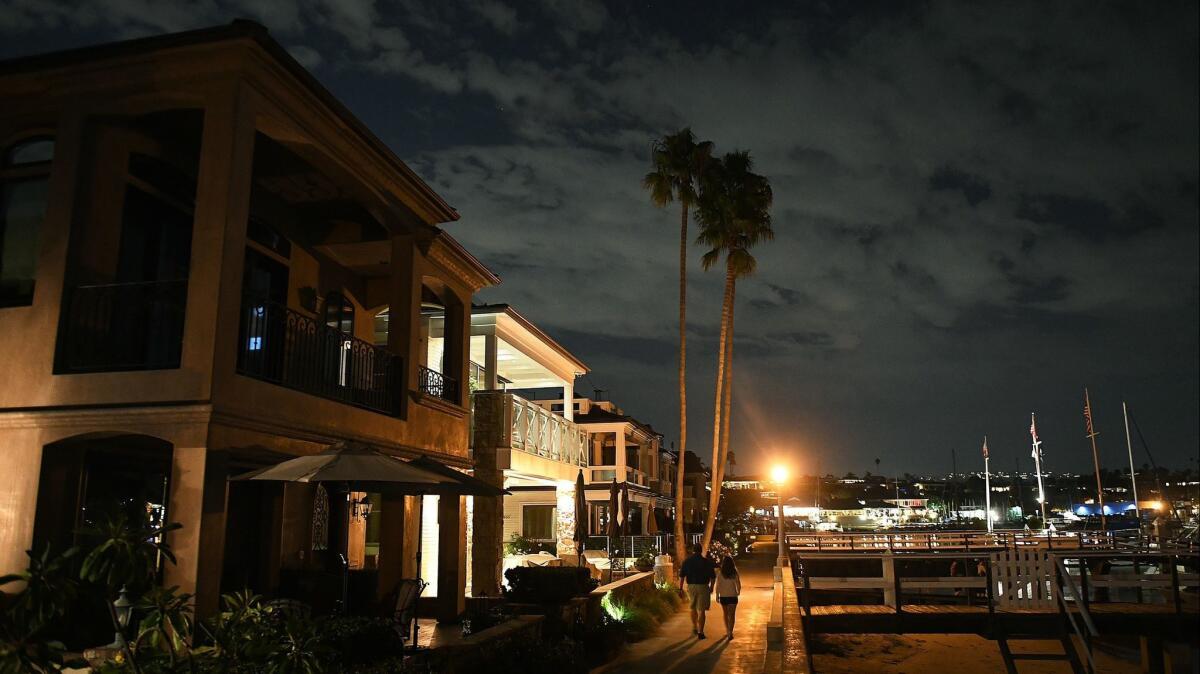Editorial: On Balboa Island, high tides foretell the dangers of rising sea levels

- Share via
The high tide at Newport Harbor on a recent morning reached nearly six feet, which is substantially higher than normal for this stretch of coast. Walking in predawn darkness along Balboa Island’s cement seawall, I could hear waves crashing noisily in the distance on the far side of Balboa Peninsula. Past storms have surged water over the top of the seawall; on this morning, the waves were not quite that strong, but the tide swamped Balboa’s narrow beaches and washed against sections of the seawall, an ominous warning of rising seas driven by global warming.
The city of Newport Beach recently added nine more inches to the top of the seawall, which dates to the 1920s, just a few years after Balboa Island was created by dumping dredged sand atop a natural sandbar. Building up the seawall was expected to buy as many as 15 years of protection from rising seas. Yet recent studies suggest global temperatures and ocean levels are rising faster than earlier believed, which could imperil the island sooner.
The California coast has other spots like Balboa Island, low-lying areas — both natural and man-made — whose beauty belies their precarious state. Storms and high tides already flood Imperial Beach, which is surrounded on three sides by water in southwest San Diego County. Local officials there have backed a “managed retreat” plan of moving buildings inland as the ocean encroaches. Further north in Del Mar, local officials this year took a different approach and decided to fight the incursions by adding more sand and dredging an adjacent river. Up and down the coast such risks and accommodations are being discussed as long-range planners cast a wary eye at the sea.
Enter the Fray: First takes on the news of the minute from L.A. Times Opinion »
On Balboa Island, the largest of six islands in the harbor, homes are valued significantly higher than in most of the rest of California. There are roughly 1,410 houses on the island, plus a few dozen businesses, with an average estimated market value of $2.8 million per house, which means conservatively that there’s north of $4 billion worth of real estate crowded onto the 130-acre walled-in sandbar. That’s a lot of money at risk. The homes are privately owned; the seawall is owned by the city, which spent $1.8 million on the recent capping project. How much more the city will be on the hook for, and when, is anybody’s guess and could be influenced by whether the world manages to come up with a strong enough plan to reduce carbon emissions and rein in the climb in global temperatures — and thereby hold down the rise in sea levels. But with the Trump administration denying there’s even a problem and giving cover to other industrialized nations to do less, there isn’t a lot of reason to feel optimistic that mankind, which created this problem and has the ability to fix it, will actually do so.
There are only so many seawalls that can reasonably be built or, in the case of Balboa, be made taller. Under the most extreme scenario mapped out in the 2018 National Climate Assessment delivered to Congress a few weeks ago, the ocean could rise by two feet in the next 25 years, which would mean regular flooding of Balboa Island, not to mention sections of Balboa Peninsula across the bay or sections of Venice Beach and Marina del Rey and on and on. One solution being discussed for Balboa Island is to just add to what is already here — jack up the buildings and move more fill beneath them, and raise the elevation of streets, sidewalks, underground utilities and sewer and storm drains. That’s a herculean task even in such a small community.
Now extrapolate the looming problem to all coastal areas at risk. The Union of Concerned Scientists estimates that more than 314,000 existing U.S. coastal homes and commercial properties worth $136 billion are at risk of “chronic inundation” by 2045. That future can be discerned in the predawn hours here on Balboa Island, foretold by the gentle lapping of water on the other side of a low, narrow wall.
Scott Martelle is a member of The Times Editorial Board.
Follow the Opinion section on Twitter @latimesopinion or Facebook
More to Read
A cure for the common opinion
Get thought-provoking perspectives with our weekly newsletter.
You may occasionally receive promotional content from the Los Angeles Times.










